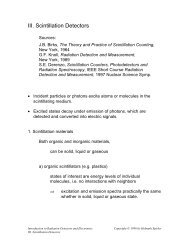Introduction to radiation-resistant semiconductor devices and circuits
Introduction to radiation-resistant semiconductor devices and circuits
Introduction to radiation-resistant semiconductor devices and circuits
You also want an ePaper? Increase the reach of your titles
YUMPU automatically turns print PDFs into web optimized ePapers that Google loves.
More detailed information on these processes can be in texts on IC technology, for<br />
example (39).<br />
Junction isolation is very robust, but requires substantial additional space.<br />
Oxide isolation allows higher packing densities <strong>and</strong> is used by most high-density IC<br />
processes. All CMOS processes utilize some form of oxide isolation, whereas<br />
bipolar transis<strong>to</strong>r processes can be found with both junction <strong>and</strong> oxide isolation.<br />
Under ir<strong>radiation</strong> the oxide layers used for isolation suffer from the same phenomena<br />
described for the gate oxide of MOSFETs (see field oxide in Fig. 2). Since<br />
isolation oxides are thicker than gate oxides, more electron-hole pairs are formed<br />
by incident <strong>radiation</strong>. Furthermore, the fields in the isolation oxide tend <strong>to</strong> be much<br />
lower, so charge trapping in the oxide will be exacerbated. Developing <strong>radiation</strong>hard<br />
isolation oxides (field oxides) was a major challenge in the development of<br />
high-density <strong>radiation</strong>-hard CMOS <strong>and</strong> remains one of the few “secret” process<br />
ingredients (for a basic discussion see (6)).<br />
Problems can occur when inherently <strong>radiation</strong>-hard <strong>devices</strong>, notably JFETs <strong>and</strong><br />
bipolar transis<strong>to</strong>rs, are used in a non-hardened oxide-isolated processes. Here<br />
<strong>radiation</strong> effects in the isolation structures can severely affect the <strong>radiation</strong> resistance<br />
of the <strong>devices</strong>. Clues <strong>to</strong> the importance of such parasitic ionization effects<br />
can be gleaned from a comparison of neutron <strong>and</strong> pho<strong>to</strong>n ir<strong>radiation</strong>s. Conventional<br />
(non-hardened) processes using oxide isolation have yielded good results in<br />
measurements <strong>to</strong> fluences >10 14 cm -2 (27,28), demonstrating that oxide isolation<br />
can be acceptable <strong>and</strong> that the suitability of these processes must be determined<br />
case-by-case.<br />
IC processes also use special device structures <strong>to</strong> facilitate the integration of<br />
different device types. A prime example is the lateral pnp transis<strong>to</strong>r, a structure<br />
more compatible with a st<strong>and</strong>ard CMOS process than “classic” vertical bipolar<br />
transis<strong>to</strong>rs. In a lateral transis<strong>to</strong>r the emitter, base <strong>and</strong> collec<strong>to</strong>r are arranged along<br />
the surface of the silicon with large-area exposure <strong>to</strong> oxide interfaces. Unlike<br />
vertical bipolar transis<strong>to</strong>rs, lateral <strong>devices</strong> are very susceptible <strong>to</strong> ionizing <strong>radiation</strong>,<br />
as surface leakage causes severe degradation of DC current gain. Lateral pnp<br />
transis<strong>to</strong>rs can be used as current sources or high impedance loads, if the biasing<br />
circuitry is designed <strong>to</strong> accommodate substantial increases in base currents.<br />
MITIGATION TECHNIQUES<br />
Although little can be done <strong>to</strong> reduce <strong>radiation</strong> damage in a given device,<br />
many techniques can be applied <strong>to</strong> reduce the effects of <strong>radiation</strong> damage <strong>to</strong> an<br />
overall system. The goal of <strong>radiation</strong>-hard design is not so much <strong>to</strong> obtain a system<br />
whose characteristics do not change under ir<strong>radiation</strong>, rather than <strong>to</strong> maintain the<br />
20





